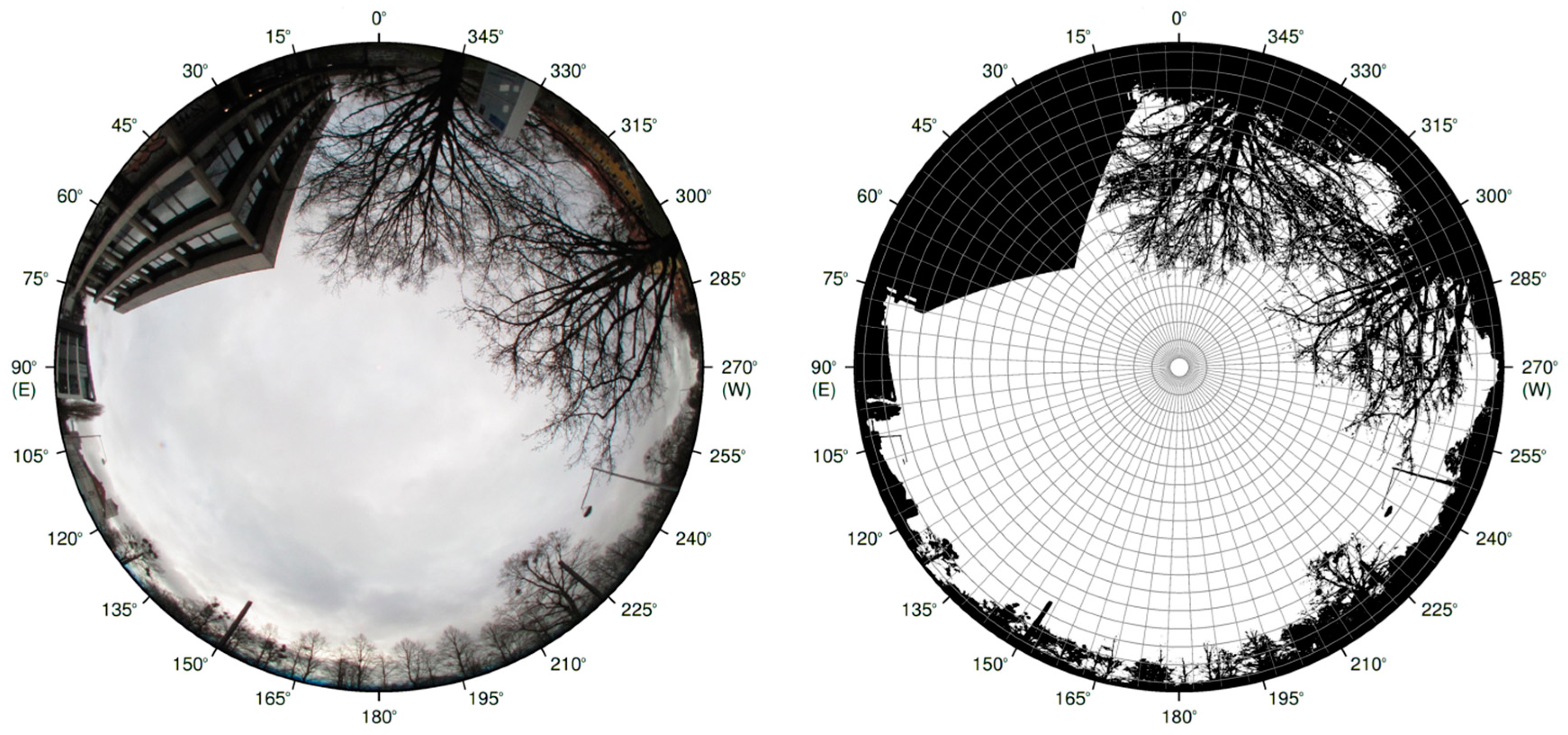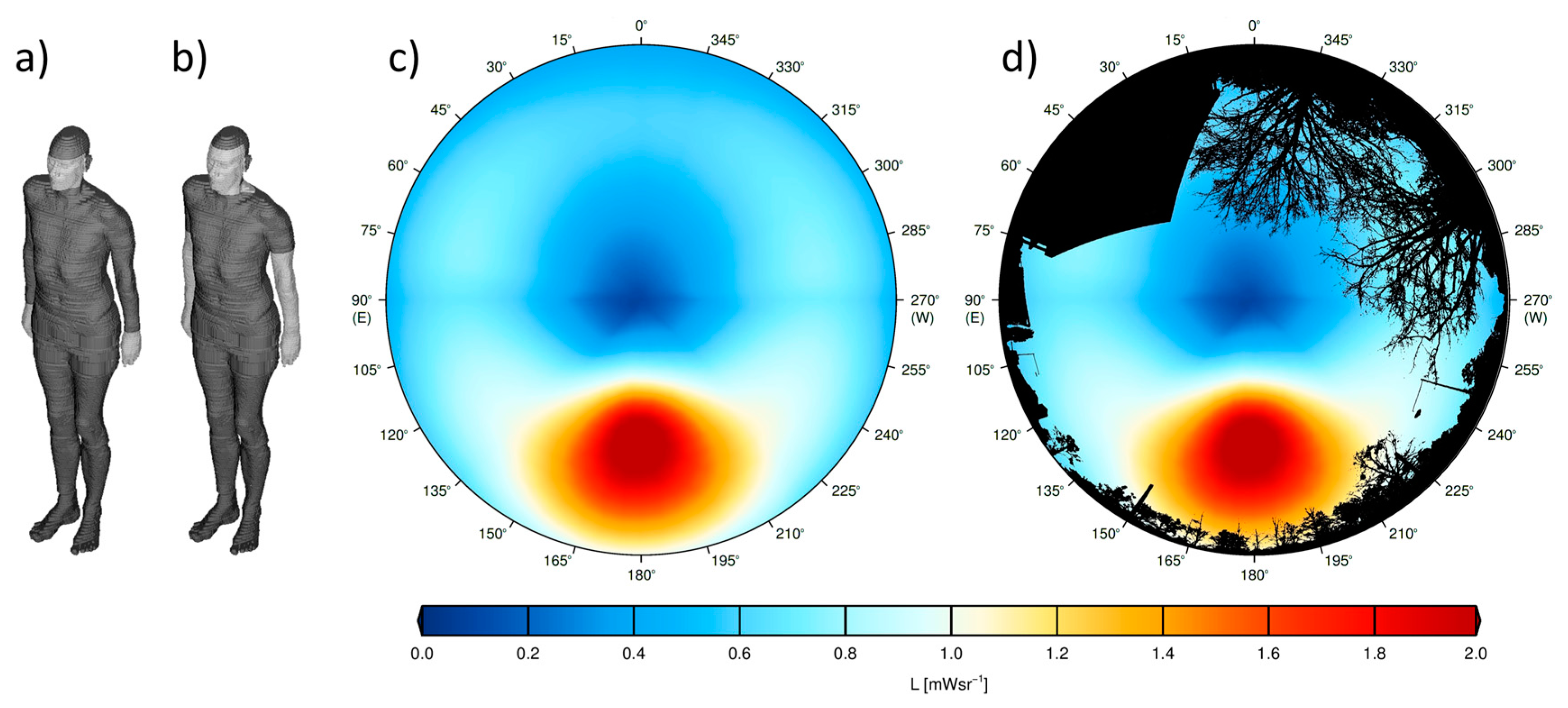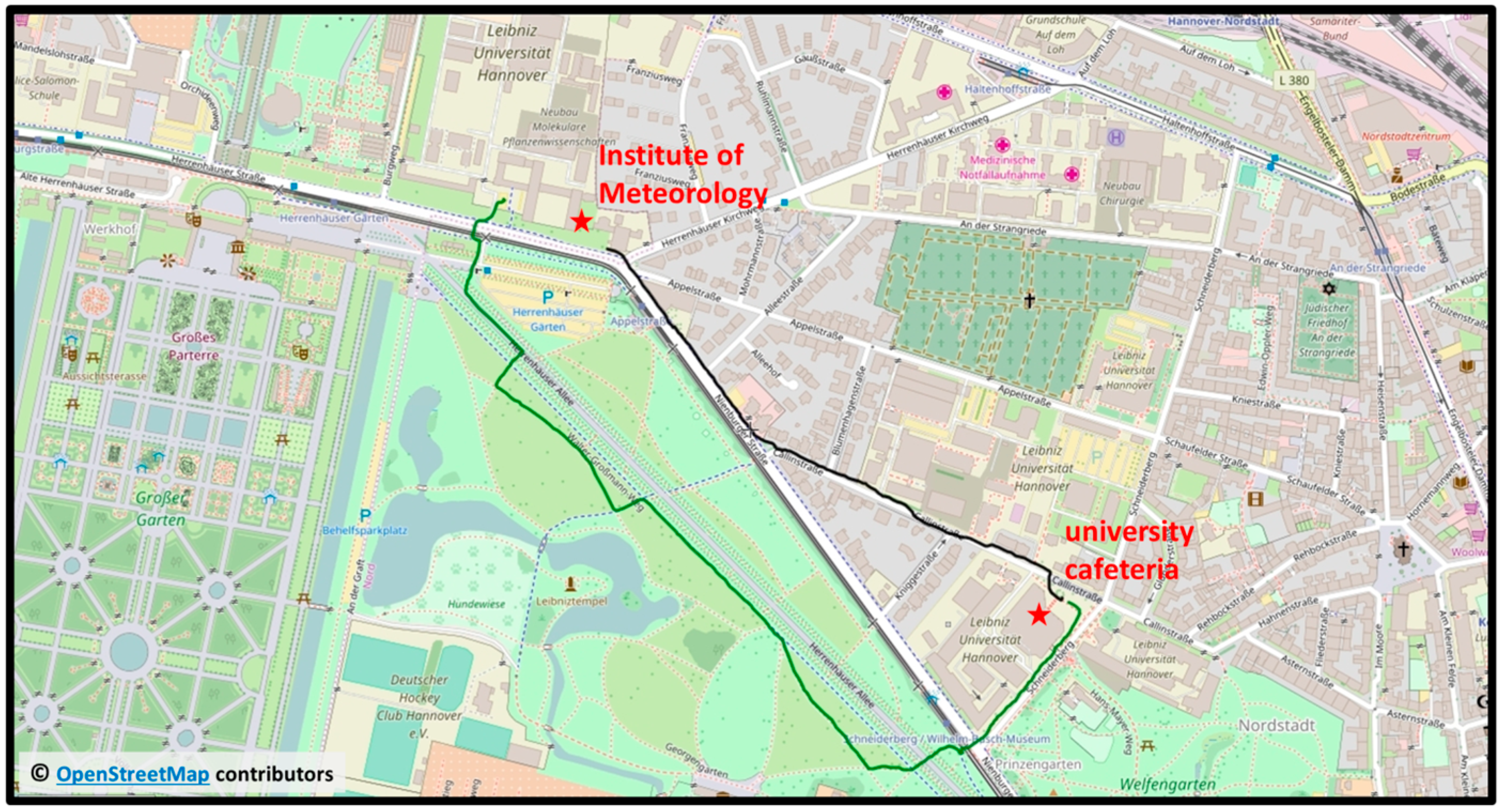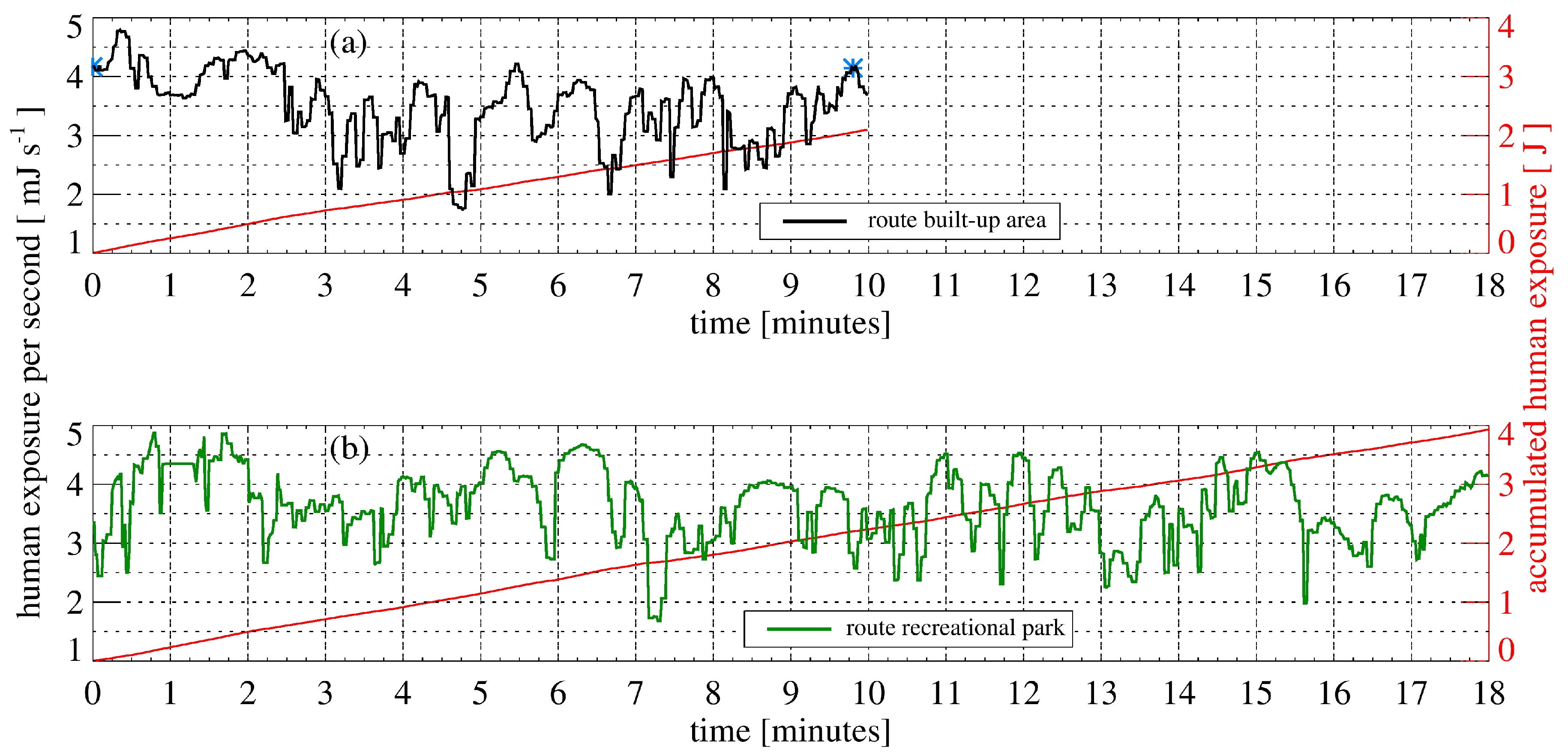Impact of Orientation on the Vitamin D Weighted Exposure of a Human in an Urban Environment
Abstract
:1. Introduction
2. Materials and Methods
2.1. State of the Art
2.2. Advanced Model
3. Results
4. Discussion
5. Conclusions
Acknowledgments
Author Contributions
Conflicts of Interest
References
- Seckmeyer, G.; Zittermann, A.; McKenzie, R.; Greinert, R. Solar radiation: 13. Solar radiation and human health. In Encyclopedia of Sustainability Science and Technology; Geuymard, C., Ed.; Springer: New York, NY, USA, 2012; pp. 9649–9672. [Google Scholar]
- Lucas, R.M.; McMichael, A.J.; Armstrong, B.K.; Smith, W.T. Estimating the global disease burden due to ultraviolet radiation exposure. Int. J. Epidemiol. 2008, 37, 654–667. [Google Scholar] [CrossRef] [PubMed]
- Juzeniene, A.; Brekke, P.; Dahlback, A.; Andersson-Engels, S.; Reichrath, J.; Moan, K.; Holick, M.F.; Grant, W.B.; Moan, J. Solar radiation and human health. Rep. Prog. Phys. 2011, 74, 56. [Google Scholar] [CrossRef]
- Lucas, R.; McMichael, T.; Smith, W.; Armstrong, B. Solar ultraviolet radiation: Global burden of disease from solar ultraviolet radiation. In Environmental Burden of Disease Series, No. 13; World Health Organization: Geneva, Switzerland, 2006. [Google Scholar]
- Haluza, D.; Simic, S.; Höltge, J.; Cervinka, R.; Moshammer, H. Connectedness to nature and public (skin) health perspectives: Results of a representative, population-based survey among Austrian residents. Int. J. Environ. Res. Public Health 2014, 11, 1176–1191. [Google Scholar] [CrossRef] [PubMed]
- World Health Organization, International Agency for Research on Cancer. Vitamin D and Cancer; Iarc Working Group Reports; WHO Press: Geneva, Switzerland, 2008; p. 148. [Google Scholar]
- IARC, Working Group on Vitamin D. Vitamin D and Cancer/A Report of the Iarc Working Group on Vitamin D; IARC Working Group Report; World Health Organisation, International Agency for Research on Cancer: Lyon, France, 2008; p. 449. [Google Scholar]
- Grant, W.B. The role of geographical ecological studies in identifying diseases linked to UVB exposure and/or vitamin D. Dermato-Endocrinology 2016, 8, e1137400. [Google Scholar] [CrossRef] [PubMed]
- Moukayed, M.; Grant, W.B. Molecular link between vitamin D and cancer prevention. Nutrients 2013, 5, 3993–4021. [Google Scholar] [CrossRef] [PubMed]
- Grant, W.B. Roles of solar uvb and vitamin D in reducing cancer risk and increasing survival. Anticancer Res. 2016, 36, 1357–1370. [Google Scholar] [PubMed]
- Moukayed, M.; Grant, W.B. The roles of UVB and vitamin D in reducing risk of cancer incidence and mortality: A review of the epidemiology, clinical trials, and mechanisms. Rev. Endocr. Metab. Disord. 2017, 18, 167–182. [Google Scholar] [CrossRef] [PubMed]
- Biesalski, H.K.; Köhrle, J.; Schürmann, K. Vitamine, Spurenelemente Und Mineralstoffe; Georg Thieme Verlag: Stuttgart, Germany, 2002; p. 820. ISBN 978-3-13-129371-8. [Google Scholar]
- Webb, A.R.; Kift, R.; Durkin, M.T.; O’Brien, S.J.; Vail, A.; Berry, J.L.; Rhodes, L.E. The role of sunlight exposure in determining the vitamin D status of the U.K. White adult population. Br. J. Dermatol. 2010, 1050–1055. [Google Scholar] [CrossRef] [PubMed]
- Wabitsch, M.; Koletzko, B.; Moß, A. Vitamin-D-versorgung im säuglings-, kindes- und jugendalter. Monatsschrift Kinderheilkd. 2011, 159, 766–774. [Google Scholar] [CrossRef]
- Holick, M.F. Vitamin D: Importance in the prevention of cancers, type 1 diabetes, heart disease, and osteoporosis. Am. J. Clin. Nutr. 2004, 79, 362–371. [Google Scholar] [PubMed]
- Zittermann, A. The estimated benefits of vitamin D for Germany. Mol. Nutr. Food Res. 2010, 1164–1171. [Google Scholar] [CrossRef] [PubMed]
- Diffey, B.L. Is casual exposure to summer sunlight effective at maintaining adequate vitamin D status? Photodermatol. Photoimmunol. Photomed. 2010, 26, 172–176. [Google Scholar] [CrossRef] [PubMed]
- Webb, A.R.; Kline, L.; Holick, M.F. Influence of season and latitude on the cutaneous synthesis of vitamin D3: Exposure to winter sunlight in boston and edmonton will not promote vitamin D3 synthesis in human skin. J. Clin. Endocrinol. Metab. 1988, 67, 373–378. [Google Scholar] [CrossRef] [PubMed]
- Zeeb, H.; Greinert, R. Übersichtsarbeit: Bedeutung von vitamin D in der krebsprävention: Konflikt zwischen UV-schutz und anhebung niedriger vitamin-D-spiegel? Dtsch. Arzteblatt-Arztliche Mitt.-Ausg. B 2010, 107, 638–647. [Google Scholar]
- McKenzie, R.L.; Liley, J.B.; Björn, L.O. UV radiation: Balancing risks and benefits. Photochem. Photobiol. 2009, 85, 88–98. [Google Scholar] [CrossRef] [PubMed]
- Godar, D.E.; Pope, S.J.; Grant, W.B.; Holick, M.F. Solar UV doses of adult Americans and vitamin D3 production. Dermato-Endocrinology 2011, 3, 243–250. [Google Scholar] [CrossRef] [PubMed]
- Godar, D.E.; Pope, S.J.; Grant, W.B.; Holick, M.F. Solar UV doses of young Americans and vitamin D3 production. Environ. Health Perspect. 2012, 120, 139–143. [Google Scholar] [CrossRef] [PubMed]
- Pope, S.J.; Godar, D.E. Solar UV geometric conversion factors: Horizontal plane to cylinder model. Photochem. Photobiol. 2010, 86, 457–466. [Google Scholar] [CrossRef] [PubMed]
- Kawanishi, T. Evaluation of ultraviolet radiation protection of a membrane structure using a uc shade chart. In Proceedings of the ANZAScA2010, Auckland, New Zealand, 24–26 November 2010. [Google Scholar]
- Parisi, A.V.; Kimlin, M.G.; Wong, J.; Wilson, M. Personal exposure distribution of solar erythemal ultraviolet radiation in tree shade over summer. Phys. Med. Biol. 2000, 45, 349. [Google Scholar] [CrossRef] [PubMed]
- Parisi, A.V.; Eley, R.; Downs, N. Determination of the usage of shade structures via a dosimetry technique. Photochem. Photobiol. 2012, 88, 1012–1015. [Google Scholar] [CrossRef] [PubMed] [Green Version]
- Seckmeyer, G.; Schrempf, M.; Wieczorek, A.; Riechelmann, S.; Graw, K.; Seckmeyer, S.; Zankl, M. A novel method to calculate solar UV exposure relevant to vitamin D production in humans. Photochem. Photobiol. 2013, 89, 974–983. [Google Scholar] [CrossRef] [PubMed]
- CIE. S 017: ILV: International Lighting Vocabulary; CIE: Vienna, Austria, 2011. [Google Scholar]
- Valentin, J. Basic anatomical and physiological data for use in radiological protection: Reference values: Icrp publication 89. Ann. ICRP 2002, 32, 1–277. [Google Scholar] [CrossRef]
- Tohsing, K.; Schrempf, M.; Riechelmann, S.; Schilke, H.; Seckmeyer, G. Measuring high-resolution sky luminance distributions with a ccd camera. Appl. Opt. 2013, 52, 1564–1573. [Google Scholar] [CrossRef] [PubMed]
- Feister, U.; Grewe, R. Spectral albedo measurements in the UV and visible regions over different types of surfaces. Photochem. Photobiol. 1995, 62, 736–744. [Google Scholar] [CrossRef]
- McKenzie, R.; Kotkamp, M.; Ireland, W. Upwelling UV spectral irradiances and surface albedo measurements at Lauder, New Zealand. Geophys. Res. Lett. 1996, 23, 1757–1760. [Google Scholar] [CrossRef]
- Shettle, E.P. Models of Aerosols, Clouds, and Precipitation for Atmospheric Propagation Studies. In Atmospheric Propagation in the UV, Visible, IR and mm-Region and Related System Aspects, Proceedings of the AGARD no. 454, Copenhagen, Denmark, 9–13 October 1989; AGARD: Neuilly sur Seine, France, 1989. [Google Scholar]
- Openstreetmap Copyright and License. Available online: http://www.openstreetmap.org/copyright (accessed on 14 August 2017).
- Holick, M.F. Vitamin D deficiency. N. Engl. J. Med. 2007, 357, 266–281. [Google Scholar] [CrossRef] [PubMed]
- Holick, M.F. Vitamin D: The underappreciated d-lightful hormone that is important for skeletal and cellular health. Curr. Opin. Endocrinol. Diabetes Obes. 2002, 9, 87–98. [Google Scholar] [CrossRef]
- Webb, A.R.; Engelsen, O. Calculated ultraviolet exposure levels for a healthy vitamin D status. Photochem. Photobiol. 2006, 82, 1697–1703. [Google Scholar] [CrossRef] [PubMed]
- Engelsen, O. The relationship between ultraviolet radiation exposure and vitamin D status. Nutrients 2010, 2, 482–495. [Google Scholar] [CrossRef] [PubMed] [Green Version]
- Riechelmann, S.; Schrempf, M.; Seckmeyer, G. Simultaneous measurement of spectral sky radiance by a non-scanning multidirectional spectroradiometer (mudis). Meas. Sci. Technol. 2013, 24, 125501. [Google Scholar] [CrossRef]
- Seckmeyer, G.; Klingebiel, M.; Riechelmann, S.; Lohse, I.; McKenzie, R.L.; Ben Liley, J.; Allen, M.W.; Siani, A.M.; Casale, G.R. A critical assessment of two types of personal UV dosimeters. Photochem. Photobiol. 2012, 88, 215–222. [Google Scholar] [CrossRef] [PubMed]






| Route | Exposure of a Human 21 March (Winter Clothing) | Exposure of a Human 21 June (Summer Clothing) | ||
|---|---|---|---|---|
| (IU) | (IU) | |||
| Built-up area (unobstructed) | 3.48 | 247 | 19.26 | 1367 |
| Built-up area (obstructed) | 2.10 | 149 | 10.14 | 720 |
| Recreational park (unobstructed) | 6.26 | 444 | 35.44 | 2515 |
| Recreational park (obstructed) | 3.94 | 280 | 16.28 | 1155 |
© 2017 by the authors. Licensee MDPI, Basel, Switzerland. This article is an open access article distributed under the terms and conditions of the Creative Commons Attribution (CC BY) license (http://creativecommons.org/licenses/by/4.0/).
Share and Cite
Schrempf, M.; Thuns, N.; Lange, K.; Seckmeyer, G. Impact of Orientation on the Vitamin D Weighted Exposure of a Human in an Urban Environment. Int. J. Environ. Res. Public Health 2017, 14, 920. https://doi.org/10.3390/ijerph14080920
Schrempf M, Thuns N, Lange K, Seckmeyer G. Impact of Orientation on the Vitamin D Weighted Exposure of a Human in an Urban Environment. International Journal of Environmental Research and Public Health. 2017; 14(8):920. https://doi.org/10.3390/ijerph14080920
Chicago/Turabian StyleSchrempf, Michael, Nadine Thuns, Kezia Lange, and Gunther Seckmeyer. 2017. "Impact of Orientation on the Vitamin D Weighted Exposure of a Human in an Urban Environment" International Journal of Environmental Research and Public Health 14, no. 8: 920. https://doi.org/10.3390/ijerph14080920






